So, everyone and his uncle wants a retro-styled motorcycle these days, and bike manufacturers are more than happy to fulfil this need. It is a matter of meeting market needs and generating profits, after all.
I mean, what’s so difficult about it? You take an engine, throw it in a steel cradle frame which is cheaper than any sort of aluminium beam frame you can design, grab a design from the sixties or seventies and there you have it.
A little astute marketing, sell the image, and you will have droves of hipsters lining up to buy these things, which are then sold for a premium over motorcycles that cost less, but perform better. But, sometimes, just occasionally, the sweet spot is hit, and you do get a retro machine that delivers what is asked for in image, and can actually go round corners in an interesting fashion.
Case in point is the 2017 Triumph Street Scrambler priced at RM65,900 including GST, which follows on from the “Modern Classics” range. The earlier models in the lineup took Triumph’s classic design style, and put it on the T120 and Street Twin machines, which, unsurprisingly, have become best sellers.
While we have previously ridden the Triumph T120 Dark and Bonneville Bobber, along with other retro bikes such as the Ducati Scrambler Icon and Moto Guzzi V7 Cafe Racer, the Street Scrambler intrigued us, as we have always been a fan of stripped-down motorcycles with an eye to performance. As we were to find out, the Street Scrambler is the same as, but different from, the current crop of retro bikes on the market.
When we first picked up the Street Scrambler, we were not surprised that it resembled the Street Twin, its more classically-styled sibling, closely. The similarities ended there though, with a set of wide handlebars – 835 mm in width – and the upswept exhaust pipes that exited on the right, just under the rider’s thigh.
When the first pictures of the Street Scrambler were released, many asked if the pipes were close enough to cause, shall we say, heating problems. The answer is, yes, if you are below 168 cm in height.
The reason we know this is because the author is exactly that tall, and at standstill, with both feet down, the inside of the right thigh will brush against the exhaust guard. Which then causes a slow roast of the rider’s flesh. This of course means if you happen to be on the short side, like the author, leave the board shorts at home and wear riding jeans.
We got around the problem by right-footing it at stop lights, leaning the Street Scrambler over slightly more to increase the gap between the inside of the thigh and the exhaust. The other alternative would be to only use the left foot, leaving the right on the foot peg, at stops.
Either way, we did not count this as a major problem. Just something to be aware of and the need to adjust seating habits on the Street Scrambler. On the move, there was absolutely no issue, with engine and exhaust heat directed away from the rider.
Now that that question has been answered, what is the rest of the Street Scrambler like? Well, as a retro machine, what you do get for your purchase price are the basics – engine, two wheels, tank, seat, suspension and brakes.
This is not a bad thing, as one thing we have always believed in is that a motorcycle reduced to the bare essence of riding allows the rider to concentrate the important thing, riding.
Getting on the Street Scrambler is a breeze, the 790 mm tall seat being a long-ish scrambler type affair patterned after the bikes of the seventies. There is a removable pillion pad which allows the bike to then take on the authentic scrambler single-seat look.
There is something that Triumph did get right with the Street Scrambler and that’s the engine. Displacing 900 cc, the 270-degree eight-valve, SOHC parallel-twin gives out that characteristic British twin vibe, but in a rather more civilised manner.
The author’s basis for comparison? A 1953 Triumph 5T Speed Twin in the stable, with 180-degree crank and pushrod valves. It was thus a pleasant surprise to sit in the saddle of something that felt familiar, but muted and slightly less fatiguing.
Thumbing the EFI-fed twin to life gives the rider access to 55 hp at 6,800 rpm and 80 Nm of torque at 2,850 rpm. Now, sports bike riders might scoff at the power figure, but take a close look at where the peak torque comes in.
This allows the Street Scrambler almost instant pull in any gear, and we found this out riding it around our usual course up the mountain and back again. Leaving the Scrambler in fourth out of the five gears available, the bike responded to the throttle with eagerness, and sliced the corners like a blade through butter.
It would not keep up with more modern machinery, of course, but what the Street Scrambler is all about is the ride, and the sheer fun of throwing a motorcycle into a corner, with the rider feeling in control every step of the way. There is a caveat to this, though, and that is the suspension.
The KYB front suspension on the Street Scrambler felt a little choppy, a result of a bit too much rebound, while the KYB twin shock absorber assembly at the rear was much the same. With 120 mm of suspension travel available front and rear, there was enough suspension compliance available for things to be comfortable when taking things easy and at highway speeds, but start pushing hard and you will feel every single rut and bump in the road.
Adjustable only for pre-load in the rear, the Street Scrambler forces the rider to ride to the bike, and not the other way round. Younger riders brought up on a diet of fully-adjustable suspension might not understand this, but back in the bad old days, we made do with what we had, and what we did was come out with creative ways of taking corners, with body position and placement of weight being paramount.
Ride the Street Scrambler like a modern street bike and you are going to end up on your arse in short time. Use body English and let it all hang out, and you’ll be fine.
As we rode the Scrambler around, including one epic multi-state trip up the West Coast and back down the highway, we found it to be a fairly capable mile-muncher. Despite the lack of any sort of bodywork, hunching down and pushing the rider’s arse back in the seat allowed extra-legal highway speeds to be achieved, and quite easily.
There was not a lot top-end power to be had in the Scrambler, simply because of the way the engine delivers its power, but once the bike gets there, it stays there. This led to a fair amount of leaning the bike over and staying upright, something which made our riding buddies – one on a Harley and the other on a Panigale – scratch their heads in puzzlement.
Seat comfort on the highway stint was quite good, though not armchair soft. The long seat was padded in the right places, there was more than enough room to move around to relieve saddle soreness, and the upright seating position helped.
That is simply the nature of things on the Scrambler, which enjoys being ridden in the old school style. Stay with the bike, and lean it over as far as you dare. No hanging-off, knee-down heroics here, just choosing the optimum racing line and following through.
When hustling the Street Scrambler through turns and curves, we became aware of its weight, or more accurately, the lack thereof. According to the specifications sheet, the twin clocks in at 206 kg dry, which is a lot of weight for what is supposed to be a stripped-down motorcycle.
But, as our friend Nik Huzlan says, and we concur, it is not what what it weighs, but where the weight is placed. In the case of Triumph’s retro scrambler, it behaves like it weighs 20 kg less, and you do not ever feel that the bike is ponderous or heavy in any way.
In this, the Triumph engineers got the balance right, and attention has been given to the way the bike behaves and what it is like to ride. However, with 200-plus kg to stop, the single discs front and rear were given a real workout during the Street Scrambler’s time with us.
Clamping a 310 mm disc in front and a 255 mm disc at the back, we found that for stops in a hurry, both front and rear brakes needed to be brought into play. Also, no single-finger Brembo type stroking of the brake lever here, you need to brake like you mean it.
But saying that, braking on the Street Scrambler was drama free, and the bike felt composed throughout our emergency braking tests. The standard ABS and traction control play a big part in this, and not a lot upset the Scrambler as we took it through the paces.
Switching off both the traction control and ABS increased the fun factor of the Street Scrambler by several orders of magnitude, and if you’re an experienced rider, you will definitely want to do this. With only 50-odd hp on tap, there is no danger of catapulting yourself to the moon, and the feeling of the rear wheel stepping out and coming back again reminded the author of his teenage years wrestling a DT125 two-stroker around in the dirt.
The rest of the Street Scrambler’s modern conveniences, aside from the ABS and traction control, is pretty basic, with a single analogue speedometer in the cockpit and a secondary LCD readout showing the usual information. There are three colour options available – Jet Black, Korosi Red/Frozen Silver (as reviewed) and Matte Khaki Green.
So, who needs a 2017 Triumph Street Scrambler at RM65,900? At this price point, the main competition for the Street Scrambler is the Ducati Scrambler, in Classic, Urban Enduro and Full Throttle flavours at RM62,999, but they lack the traction control of the Hinckley bike.
For the rider who is not interested ultimate performance, but wants a run-about that looks different, the Street Scrambler fits the bill. That the Street Scrambler handles well and can cruise at highway speeds in reasonable fashion is a plus.
A wide selection of accessories from the Triumph catalogue will allow the rider to customise the bike to suit whatever role is required. If you’re a rider who does need feel the need to follow the herd, and is in it more for the ride than the pose value, then the Street Scrambler might fit the bill.

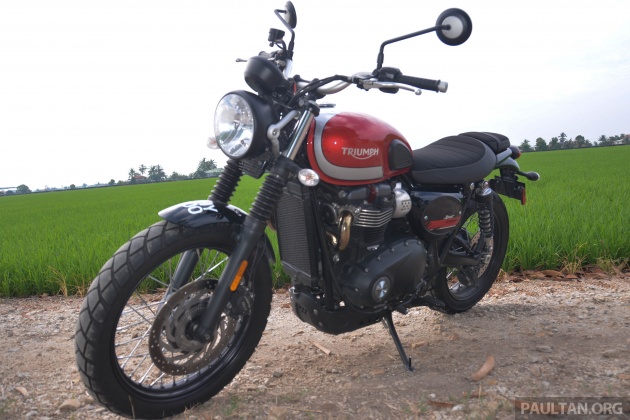

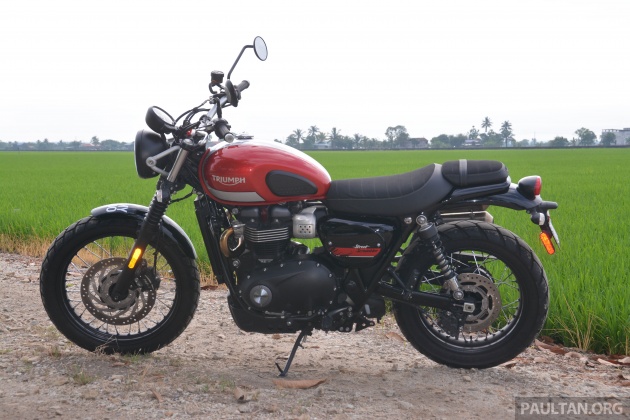



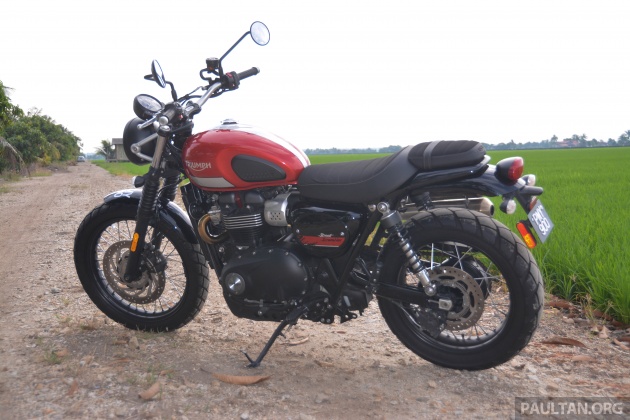
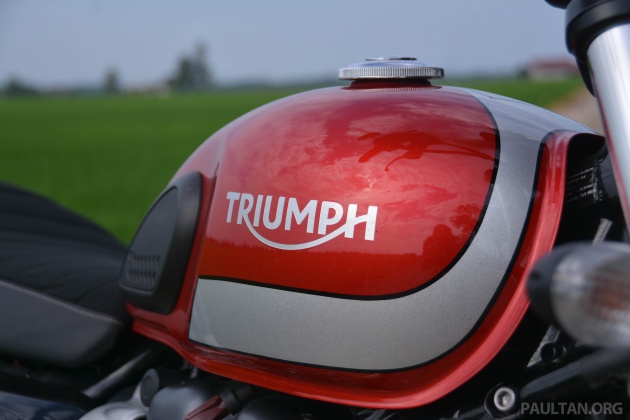
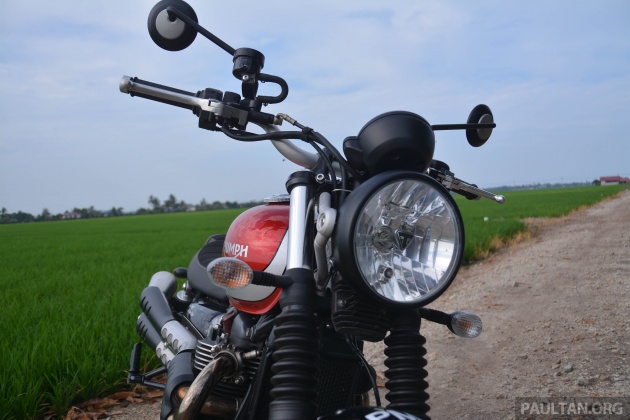






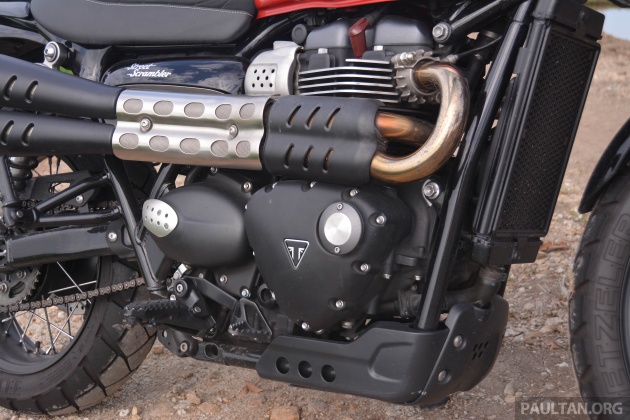



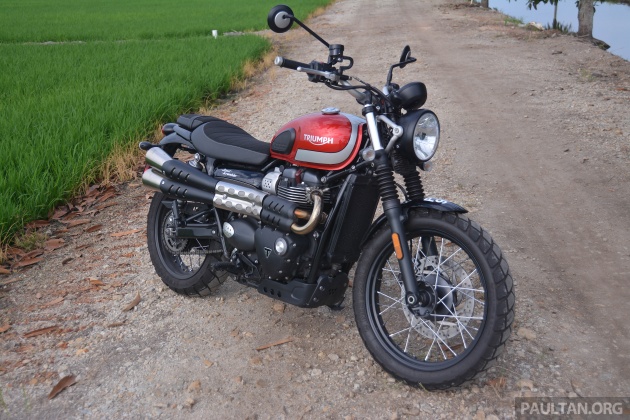
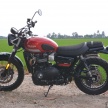

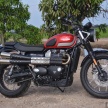
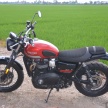
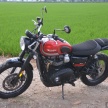
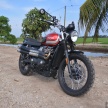
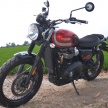

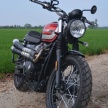
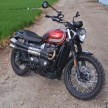
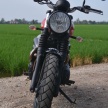
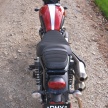
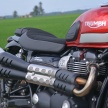

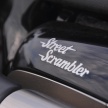
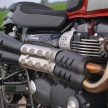
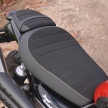
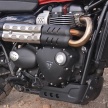
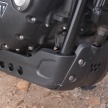
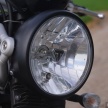
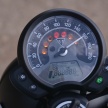
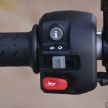
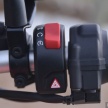
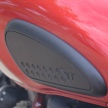
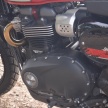
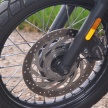
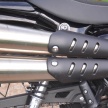
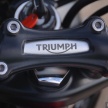
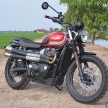
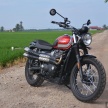
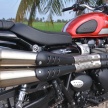
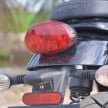

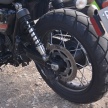
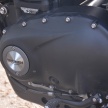
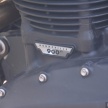
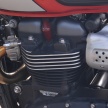
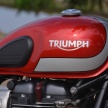
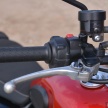
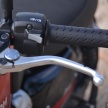
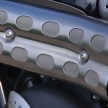
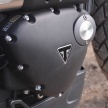
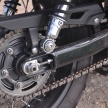
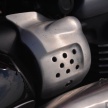
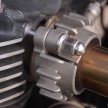
Poorly designed exhaust, an eyesore to look at, overpriced and actually looks like it was made in the jungle depths of rural Laos….
Looks more like a street bike. Scrambler have long absorbers to take high drops.
The Scrambler was designed as a Bonneville with off road styling and limited off road capability.
Would be surprised if they manage to sell even one unit.
it’s ok. Decent look but the pricing may not suit average Joes in Malaysia. Maybe strictly for Triumph fans.